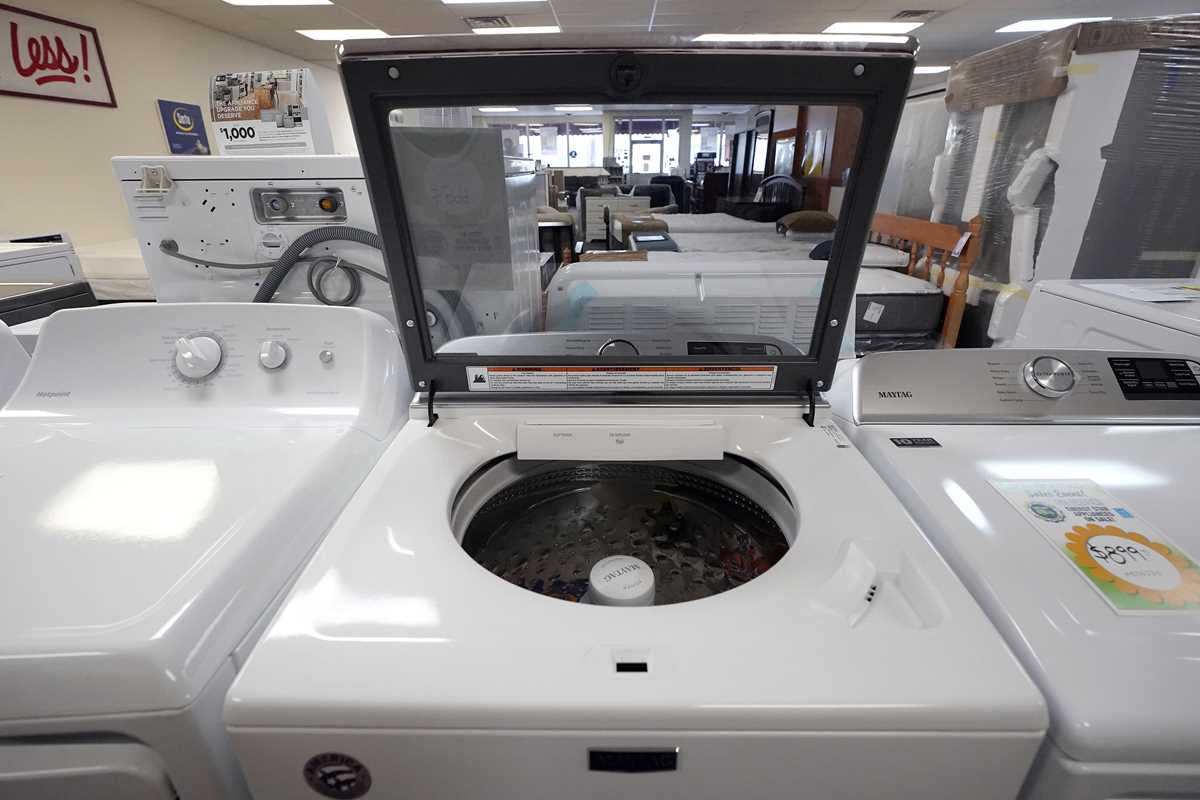 Shoppers are silhouetted against the sky as they arrives for a sale at a Best Buy store Friday, Nov. 25, 2022, in Overland Park, Kan. On Friday the Commerce Department issues its November report on consumer spending. The report contains a measure of inflation that is closely watched by the Federal Reserve, which has aggressively tried to corral inflation this year by raising its key lending rate seven times. (AP Photo/Charlie Riedel, File)
Shoppers are silhouetted against the sky as they arrives for a sale at a Best Buy store Friday, Nov. 25, 2022, in Overland Park, Kan. On Friday the Commerce Department issues its November report on consumer spending. The report contains a measure of inflation that is closely watched by the Federal Reserve, which has aggressively tried to corral inflation this year by raising its key lending rate seven times. (AP Photo/Charlie Riedel, File) New cars are delivered to a dealer in Pittsburgh on Thursday, Sept. 29, 2022. On Friday the Commerce Department issues its November report on consumer spending. The report contains a measure of inflation that is closely watched by the Federal Reserve, which has aggressively tried to corral inflation this year by raising its key lending rate seven times. (AP Photo/Gene J. Puskar, File)
New cars are delivered to a dealer in Pittsburgh on Thursday, Sept. 29, 2022. On Friday the Commerce Department issues its November report on consumer spending. The report contains a measure of inflation that is closely watched by the Federal Reserve, which has aggressively tried to corral inflation this year by raising its key lending rate seven times. (AP Photo/Gene J. Puskar, File) A mechanic drains oil from a car at an auto repair shop, Wednesday, July 13, 2022, in Collingdale, Pa. On Friday the Commerce Department issues its November report on consumer spending. The report contains a measure of inflation that is closely watched by the Federal Reserve, which has aggressively tried to corral inflation this year by raising its key lending rate seven times. (AP Photo/Matt Slocum, File)
A mechanic drains oil from a car at an auto repair shop, Wednesday, July 13, 2022, in Collingdale, Pa. On Friday the Commerce Department issues its November report on consumer spending. The report contains a measure of inflation that is closely watched by the Federal Reserve, which has aggressively tried to corral inflation this year by raising its key lending rate seven times. (AP Photo/Matt Slocum, File) Washing machines are displayed with other appliances at Sam's Appliances TV & Furniture, Thursday, March 25, 2021, in Norwood, Mass. On Friday the Commerce Department issues its November report on consumer spending. The report contains a measure of inflation that is closely watched by the Federal Reserve, which has aggressively tried to corral inflation this year by raising its key lending rate seven times. (AP Photo/Steven Senne, File)
Washing machines are displayed with other appliances at Sam's Appliances TV & Furniture, Thursday, March 25, 2021, in Norwood, Mass. On Friday the Commerce Department issues its November report on consumer spending. The report contains a measure of inflation that is closely watched by the Federal Reserve, which has aggressively tried to corral inflation this year by raising its key lending rate seven times. (AP Photo/Steven Senne, File)WASHINGTON (AP) — A measure of inflation closely watched by the Federal Reserve slowed last month, another sign that a long surge in consumer prices seems to be easing.
Friday's report from the Commerce Department showed that prices rose 5.5% in November from a year earlier, down from a revised 6.1% increase in October and the smallest gain since October 2021. Excluding volatile food and energy prices, so-called core inflation was up 4.7% over the previous year. That was also the smallest increase since October 2021.
On a month-to-month basis, prices rose 0.1% from October to November after rising 0.4% the previous month. Core prices rose 0.2%.
Inflation, which began surging a year and a half ago as the economy bounced back from 2020's coronavirus recession, still remains well above the 2% year-over-year growth the Fed wants to see.
The central bank has raised its benchmark interest rate seven times since March in an attempt to bring consumer prices under control.
Higher prices and borrowing costs may be taking a toll on American consumers. Their spending rose just 0.1% from October to November and didn’t rise at all after adjusting for higher prices.
“We expect a deceleration in household spending as the Fed hikes rates further in 2023,'' Rubeela Farooqi, chief U.S. economist at High Frequency Economics, wrote in a research note.
Americans' after-tax income, however, rose 0.3% in November even after accounting for inflation.
The Fed is believed to monitor the Commerce Department's inflation gauge that was issued Friday, called the personal consumption expenditures price index, even more closely than it does the Labor Department's better-known consumer price index. CPI rose 7.1% in November from 12 months earlier, down from June’s 9.1% year-over-year increase, which had been the biggest such jump in four decades.
The PCE index tends to show a lower inflation rate than CPI. In part, that is because rents, which have soared, carry double the weight in the CPI that they do in the PCE.
The PCE price index also seeks to account for changes in how people shop when inflation jumps. As a result, it can capture, for example, when consumers switch from pricey national brands to cheaper store brands.
Before you make your next trade, you'll want to hear this.
MarketBeat keeps track of Wall Street's top-rated and best performing research analysts and the stocks they recommend to their clients on a daily basis.
Our team has identified the five stocks that top analysts are quietly whispering to their clients to buy now before the broader market catches on... and none of the big name stocks were on the list.
They believe these five stocks are the five best companies for investors to buy now...
See The Five Stocks Here
Click the link below and we'll send you MarketBeat's guide to investing in 5G and which 5G stocks show the most promise.
Get This Free Report